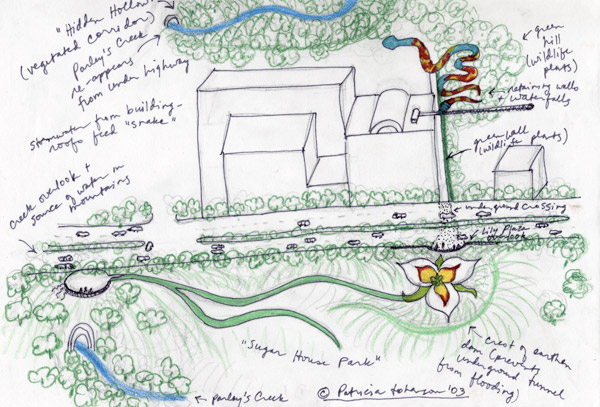
"Sugar House Pedestrian Crossing", ink and colored pencil
Copyright © 2003, Patricia Johanson
Images of the rattlesnake and the sego lily reemerge in a new public garden along Parley's Creek designed by artist Patricia Johanson in 2003. Johanson's new garden not only links the two sides of the expressway and the three branches of the trail system; it also recaptures the unity between Wasatch Mountain, Parley's Creek Valley, and the Great Salt Lake, all of which constitute a living world that the (Mormon) pioneers wrestled, adapted, transformed, and dwelt in...
Johanson's proposal features two giant sculptures, the "Sego Lily" in (Sugar House) Park and the "Rattlesnake" along Hidden Hollow. In a sketch, Parley's Creek appears distinctively on both sides. The Lily unwinds between the road and an earthen dam. The creek passes beneath its root bulb, like an endless life force nurturing the plant. The Snake looms from the other side of the expressway. Its body, with red and yellow patches, waggles among foliage and crawls into the wilderness of Hidden Hollow...
The representations of the Lily and the Snake are undoubtedly figurative and colorful, offering striking visual images... (However) the figures are camouflaged and fragmented through deliberate design. The sculptures can be experienced only piecemeal through bodily engagement with their materiality. Furthermore, the forms are not imposed upon but derived from the geomorphological characters of the site-the winding course of Parley's Creek casts the shape of the Snake, while the topography of the valley is projected into the enclosure embracing the Lily. Thus the scale of the figures is in fact the scale of landscape, and the possible meaningfulness of the figures dwells beyond their forms...
The Draw at Sugar House can be better understood with reference to the "line garden" concept that Johanson put forth in 1969. Her line gardens are meant to perform minimal intervention by directing human attention and curiosity to specific sites; and the linear paths are not avenues to designed viewpoints but eye- and foot-catchers pointing to the infinite natural world beyond...
Johanson has been rejecting the notion of "art as object" and insisting to "design beyond the visual"... She ensures that the departure point of perception in her gardens goes beyond merely the visual by making most parts of the artwork utilitarian elements. The lily root forms the trailhead and an outlook; the stem and leaf become trails; the flower turns into a plaza; and the snake transforms into retaining walls, waterfalls, paths, and ponds. Instead of seeing the sculptures, visitors engage bodily with their materiality while walking through the garden. Thus the visitors become inside explorers rather than outside observers...
A walk from the (Lily) plaza through the underpath to the sunken Draw summons up the dramatic feeling of exiting into a valley from a canyon. Thus the function of the garden as a passage harks back to the historical ravines that once occupied this site and memory of the journey of the Mormons.
Acting like a catalyst, the artwork brings attention to the landscape and presents visitors with fragmented details overlaid with ambiguous meanings. The image of the riparian corridor of Parley's Creek up to Wasatch Mountain surfaces in metonymic manner at several locations.... Each of these viewpoints frames in a particular way a visitor's retrieval of the links between the artistic form, the natural surrounding, and the cultural memory. Approaching the Snake, visitors can follow its body down to the creek bed, where they would find themselves... in the sheltered wilderness of Hidden Hollow. Even though the mountain and the canyon are not visible anymore, the serpentine form of the Snake and the watercourse of Parley's Creek would... recollect the previous images of Parley's Creek streaming down Wasatch Mountain...
Sixty-two plant species are proposed to provide food and habitat for small animals. Functional structures, such as retaining walls and the structural support incorporate niches, cubicles, perches, and nesting shelves prepared for wildlife. The vivid atmosphere of a living world takes visitors mentally away from artwork into intimate observations.... Johanson makes fostering plant and animal lives a core of her art...
Each design feature proceeds from various sources about the site, such as historic records, natural scenery, ecological links, functional concerns, and art creations, so that they each provide an entry point to interpretation. Moreover, the design deliberately switches the attention from one detail to another... The overlaying and enmeshing of different interpretative frameworks make the garden the embodiment of an entangling web of potential meaning rather than a given linear narrative...
Walking through the crossing, the art and the experience emerge into one another; they are both the framer of the journey and at the same time framed by it. Visitors are invited to refresh their understanding of a landscape that is alive.
Copyright © 2007, Xin Wu, "Walking Through the Crossing: The Draw at Sugar House Park by Patricia Johanson", CONTEMPORARY GARDEN AESTHETICS, CREATIONS AND INTERPRETATIONS, edited by Michel Conan, Dumbarton Oaks, Washington, D.C.